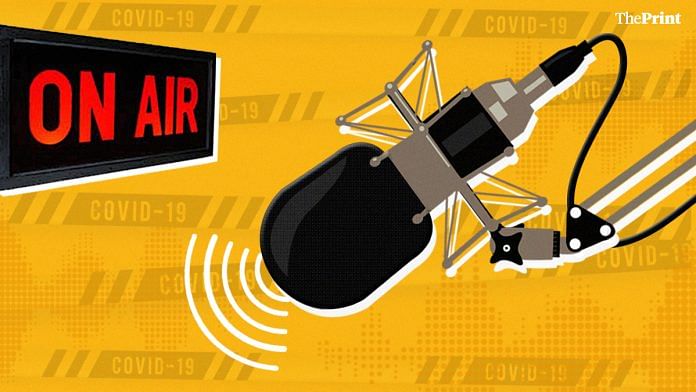With every new advancement in communication — TV, internet, smartphones — pundits have ominously announced the death of the radio in India. But the medium of the masses has more and more people tuning in, especially during the coronavirus pandemic.
In the last two and a half months, radio audiences spent 23 per cent more time listening in than pre-lockdown — contrary to the assumption that people don’t listen to radio anytime except when they’re driving to office.
Local stories, community vibe
This could be due to a number of reasons. For one, FM Radio keeps content light, a welcoming change as negative news surpass saturating levels, especially this year. Second as there was a significant dip in newspaper circulation during the lockdown, radio emerged as a preferred source of local information.
As FM Radio isn’t allowed to air any news unless it has already been aired on All India Radio, without any modifications, FM channels have walked a tight-rope during this time as they tried to keep its listeners well-informed.
According to Tuhinanshu Chaturvedi, a radio jockey at Red FM in Bengaluru, FM radio proved to be the best source of local information in the last 10 weeks. “We were in touch with authorities, the police commissioner of the city, regularly taking stock and providing updates, especially in the beginning of lockdown when the ground rules would change every day and there was lack of clarity,” he tells ThePrint.
Radio stations also busted fake news and myths surrounding Covid-19. My FM from the Bhaskar group, for instance, is running a segment dedicated to busting fake news called ‘Real ya Na-real’.
Radio City partnered with Mid Day to share everyday Covid-related information with its listeners. Reporters and editors from the newspaper would come on air to share updates, “Radio City was the first station to provide information on precautionary measures against Covid-19 when we joined hands with Dainik Jagran Inext in Uttar Pradesh,” Radio City’s CEO Ashit Kukian tells ThePrint.
Roughly, about 70 per cent content on radio was informative, up from 40-50 per cent pre-lockdown, according to Nisha Narayanan, COO and director of Red FM, who says this only goes to prove why the stringent laws guiding news regulation on radio should be lifted. “News and current affairs should be allowed on radio. TV news is driven by national news, but a guy sitting in Rajahmundry or Asansol wants to know what’s happening in the city, restrictions just make the industry difficult to thrive,” she rues.
But it’s not just disseminating news. Vinay Krishna Singh Manek, National Programming Head of My FM, says that radio stations helped create a sense of community too. “Jocks brought their own personal touch to their stories. The approach was that of a compassionate companion who will advise you rightly,” he tells ThePrint.
The important thing to note here is that FM content can’t be sombre and RJs regularly tried their best to keep the spirits up, “we provided information but didn’t let positivity die,” says Chaturvedi.
Many stations ran special segments covering lifestyle stories and suggestions on how to manage mental health during this tumultuous time. “My FM, through its initiative Tann Mann Dhan Ki Baat, provided inputs on how to manage life better — emotionally, physically and financially,” Manek elaborates.
Radio also served as a platform for stories that many news portals, TVs and local dailies would simply pass on. While the internet swooned over Sonu Sood, different radio stations brought listeners heartwarming stories of other good samaritans, perhaps not as well known as the Bollywood actor.
Salil Acharya, an RJ with Radio City in Mumbai, tells ThePrint how his station’s campaign, Dabbewale Ka Dabba Bharo, has raised about Rs 8 lakh in donation so far for Mumbai’s dabbawalas who are reeling from the economic impact of the lockdown. “Radio is telling ‘backbencher stories’, the ones nobody else would really give space to,” Acharya tells ThePrint.
The Dabbawala campaign initiative is just one among the plethora of stories FMs chose to cover. Red FM for example, collaborated with Music India and gave Rise India awards to frontline workers from across the country with the most extraordinary stories.
Also read: Live shows out, live-streaming in: What the future of performing arts could look like
Social media engagement
Even though social media isn’t new territory for radio to venture in, radio stations used the platform more aggressively during the lockdown. Radio jockeys organised many Instagram live sessions and conducted interviews on the platform.
Most radio stations saw a significant increase on their social media channels. Radio City CEO Ashit Kukian said his station witnessed a sharp increase of 280% in social media engagement.
Social media also helped reach out to people because most FMs were running pre-recorded shows, a limitation they had to function with because of lockdown restrictions. “Listeners got in touch with jocks by interacting with the stations on their social media platforms,” RJ Jay from FM Tadka in Noida tells ThePrint.
However, ad revenues still remain in the doldrums. The Association of Radio Operations For India (AROI) has written to the Central Government seeking a bailout package as Government ad spends have declined. The industry is also facing a decline in private ad expenditure.
Also read: The Pind Collective, an India-Pakistan art project that’s now focusing on responses to Covid






